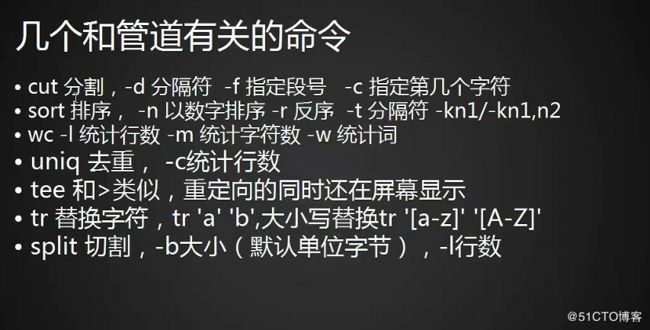8.10 shell特殊符号cut命令
8.11 sort_wc_uniq命令
8.12 tee_tr_split命令
8.13 shell特殊符号下
8.10 shell特殊符_cut命令
特殊符号
*任意个任意字符
?任意一个字符
#注释字符
在配置文件首端加入# 代表注释,后面的参数无意义,不生效。只是起到解释说明作用
\脱义字符
[root@centos7 ~]# a=1
[root@centos7 ~]# b=2
[root@centos7 ~]# echo $c
12
[root@centos7 ~]# c='$a$b'
[root@centos7 ~]# echo $c
$a$b
[root@centos7 ~]# c=\$a\$b 在有效参数字符前面加个\把$的参数脱义,让其不生效,使其变成普通字符.
[root@centos7 ~]# echo $c
$a$b
|管道符
几个和管道符相关的命令
cut 分割,截取作用。 -d 分隔符 -f指定段号 -c 指定第几个字符
[root@centos7 ~]# cat /etc/passwd |head -2 |cut -d ":" -f 1
root
bin
查看/etc/passwd的头2行,用:分割,截取第一段。
[root@centos7 ~]# cat /etc/passwd |head -2 |cut -d ":" -f 1-3
root:x:0
bin:x:1
查看/etc/passwd的头2行,用:分割,截取第一到第三段。
8.11 sort_wc_uniq命令
cut -c 指定第几个字符(使用-c的话 就不要使用-d -f了)
[root@centos7 ~]# cat /etc/passwd |head -2
root:x:0:0:root:/root:/bin/bash
bin:x:1:1:bin:/bin:/sbin/nologin
[root@centos7 ~]# cat /etc/passwd |head -2 |cut -c 4
t
:
sort排序
什么时候用#sort ?
例如现在拿到一列数字或者字符串,让它们按不同要求进行排序。
sort经常结合uniq一起使用。
test
[root@centos7 ~]# sort /etc/passwd
 可以看出sort后的文件名从小到大顺序排序。(sort根据ASCII码来进行排序)
可以看出sort后的文件名从小到大顺序排序。(sort根据ASCII码来进行排序)
test2
[root@centos7 ~]# head /etc/passwd >> 1.txt
[root@centos7 ~]# vi 1.txt
<
>
{
1.txt
2222211111
2222222aaaaa
2.txt
444448888sss
adm:x:3:4:adm:/var/adm:/sbin/nologin
bin:x:1:1:bin:/bin:/sbin/nologin
daemon:x:2:2:daemon:/sbin:/sbin/nologin
halt:x:7:0:halt:/sbin:/sbin/halt
lp:x:4:7:lp:/var/spool/lpd:/sbin/nologin
mail:x:8:12:mail:/var/spool/mail:/sbin/nologin
operator:x:11:0:operator:/root:/sbin/nologin
root:x:0:0:root:/root:/bin/bash
shutdown:x:6:0:shutdown:/sbin:/sbin/shutdown
sync:x:5:0:sync:/sbin:/bin/sync
*wwwweeq
此排序是根据ASCII码来排序得来。
-n 数字排序
使用此模式后,除数字都会被无视,被认为是0,而0是比1再前,所以第一时间显示会是非数字的内容。
test3
[root@centos7 ~]# sort -n 1.txt
<
>
{
adm:x:3:4:adm:/var/adm:/sbin/nologin
bin:x:1:1:bin:/bin:/sbin/nologin
daemon:x:2:2:daemon:/sbin:/sbin/nologin
*wwwweeq
1.txt
2.txt
2222222aaaaa
444448888sss
2222211111
-r 反序
与-n相反效果。
-t 分隔符 -kn1/-kn1,n2
用得不错 简单了解即可
wc -l 统计行数 -m 统计字符数(字数) -w 统计词
test4
[root@centos7 ~]# vi 2.txt敲入6个字符
123
abc
[root@centos7 ~]# wc -m 2.txt 为什么统计字符会是8个字符,原因是因为有了2个$,换行会产生$,只是一般会被隐藏。
8 2.txt
[root@centos7 ~]# cat -A 2.txt cat -A可以查看隐藏字符。
123$
abc$
[root@centos7 ~]# wc -w 2.txt
2 2.txt
统计有2个词。以空格或空白字符(, . $ < > )相隔一个整体未一个词。
uniq 去重(重复),-c统计行数
test5
[root@centos7 ~]# vi 2.txt
123
abc 111,222
123
abc
1
1
2
使用uniq之前,一定要排序后,再uniq去重。所以搭配sort就最佳效果了。
test6
[root@centos7 ~]# sort 2.txt
1
1
123
123
2
abc
abc 111,222
[root@centos7 ~]# sort 2.txt |uniq
1
123
2
abc
abc 111,222
统计重复出现次数 -c
[root@centos7 ~]# sort 2.txt |uniq -c
2 1
2 123
1 2
1 abc
1 abc 111,222
8.12 tee_tr_split命令
tee和 >类似,重定向的同时还在屏幕显示。
test1
[root@centos7 ~]# sort 2.txt |uniq -c > a.txt
[root@centos7 ~]# cat a.txt
2 1
2 123
1 2
1 abc
1 abc 111,222
[root@centos7 ~]# sort 2.txt |uniq -c |tee a.txt
2 1
2 123
1 2
1 abc
1 abc 111,222
由此可以见 # sort 2.txt |uniq -c |tee a.txt的效果,相当于# sort 2.txt |uniq -c > a.txt加# cat a.txt的效果。tee的作用是追加并显示追加内容。
test2
重复测试多一次
[root@centos7 ~]# >a.txt 前空白>接文件,表示清空文件内容。
[root@centos7 ~]# cat a.txt
[root@centos7 ~]# sort 2.txt |uniq -c |tee a.txt
2 1
2 123
1 2
1 abc
1 abc 111,222
[root@centos7 ~]# cat a.txt
2 1
2 123
1 2
1 abc
1 abc 111,222
效果一样 没有变化。
tee -a 表示再次追加
test3
[root@centos7 ~]# sort 2.txt |uniq -c |tee -a a.txt
2 1
2 123
1 2
1 abc
1 abc 111,222
[root@centos7 ~]# cat a.txt
2 1
2 123
1 2
1 abc
1 abc 111,222
2 1
2 123
1 2
1 abc
1 abc 111,222
2 1
2 123
1 2
1 abc
1 abc 111,222
tr 替换字符, tr 'a' 'b',大小写替换tr'[a-z]''[A-Z]'
test4
[root@centos7 ~]# echo "aminglinux" |tr '[al]' '[AL]'
AmingLinux
把aminglinux的aming中的a改成A,linux的l改成L。
test5
[root@centos7 ~]# echo "aminglinux" |tr 'a' 'A'
Aminglinux
a变成A
test6
[root@centos7 ~]# echo "aminglinux" |tr '[a-z]' '[A-Z]'
AMINGLINUX
全部变成大写。
test7
[root@centos7 ~]# echo "aminglinux" |tr '[a-z]' '1'
1111111111
把aminglinux变成1
记住tr支持多个替换,而且它们是一一对应的。
split 切割 -b大小(默认单位字节),-l行数
大文件切割成小文件。
[root@centos7 ~]# split -b 100M bigfile
针对文件,切割100M。
[root@centos7 ~]# split -l 1000 bigfire
针对行数,切割1000行。
test 8
[root@centos7 ~]# find /etc/ -type f -name "*conf" -exec cat {} >> a.txt \;
[root@centos7 ~]# du -sh a.txt
256Ka.txt
[root@centos7 ~]# mv a.txt test/
[root@centos7 ~]# cd test/
[root@centos7 test]# ls
a.txt
[root@centos7 test]# split -b 1000 a.txt
指定大小分割
[root@centos7 test]# split -b 100k a.txt
[root@centos7 test]# ls
a.txt xaa xab xac
[root@centos7 test]# du -sh *
240Ka.txt
100Kxaa
100Kxab
40Kxac
删除x*开头的文件
[root@centos7 test]# rm -rf x*
[root@centos7 test]# ls
a.txt
指定分割后的名称
[root@centos7 test]# split -b 100k a.txt FG
[root@centos7 test]# ls
a.txt FGaa FGab FGac
[root@centos7 test]# du -sh *
240Ka.txt
100KFGaa
100KFGab
40KFGac
分割行数
分割1000行
[root@centos7 test]# split -l 1000 a.txt
[root@centos7 test]# ls
a.txt FGaa FGab FGac xaa xab xac xad xae xaf xag
[root@centos7 test]# wc -l *
6112 a.txt
2401 FGaa
2695 FGab
1016 FGac
1000 xaa
1000 xab
1000 xac
1000 xad
1000 xae
1000 xaf
112 xag
8.13 shell特殊符号(下)
$变量前缀,!$组合,正则里面行尾
;多条命令写到一行,用分号;分割
[root@centos7 ~]# ls 1.txt ; wc -l 2.txt
1.txt
7 2.txt
~用户给家目录,后面正则表达式表达匹配符
&放到命令后面,会把命令丢到后台.
> >> 2> 2>> &>
> 正确重定向,会把之前的文件覆盖掉。
>> 追加重定向,正确输出
2> 错误重定向,错误输出
2>> 错误追加重定向,错误输出
&>正确与错误输出重定向。
[]指定字符中的一个,[0-9],[a-z][A-Z],[abc]
||(两个管道符)和&&,用于命令之间。(判断作用,||表示或,&&表示才。)
||用法,
用于两命令之间,如果执行两条命令,其中前面是错误命令的话,和执行第二条命令。如果前面命令是正确的话,后面的命令将不会执行。
[root@centos7 ~]# ls aaaa.txt || wc -l 2.txt
ls: 无法访问aaaa.txt: 没有那个文件或目录
7 2.txt
[root@centos7 ~]# wc -l 2.txt || ls 1.txt
7 2.txt
&&用法,
两条命令,如果前面的命令正确,后面的命令才会被执行。如果前面的命令错误,后面的命令将不会被执行。
[root@centos7 ~]# ls 1.txt && wc -l 2.txt
1.txt
7 2.txt
前面命令成功了,后面的命令继续被执行。
[root@centos7 ~]# ls 1a.txt && wc -l 2.txt
ls: 无法访问1a.txt: 没有那个文件或目录
前面命令失败了,后面的命令没有被执行。
test
创建一个目录aminglinux/,条件是不存在才创建,如果存在就不创建。
[root@centos7 ~]# [ -d aminglinux ] || mkdir aminglinux
[root@centos7 ~]# ls
1.txt 2.txt 4.txt AA.txt anaconda-ks.cfg A.txt err test
1.xtx 3.txt a_(2).txt aminglinux anaconda-ks.cfg.1 bb.txt temp.1
解释 [ -d aminglinux ] -d是否一个目录,目录是否存在。
如果文件存在,才去创建,此时会出现报错。
[root@centos7 ~]# [ -d aminglinux ] && mkdir aminglinux
mkdir: 无法创建目录"aminglinux": 文件已存在





